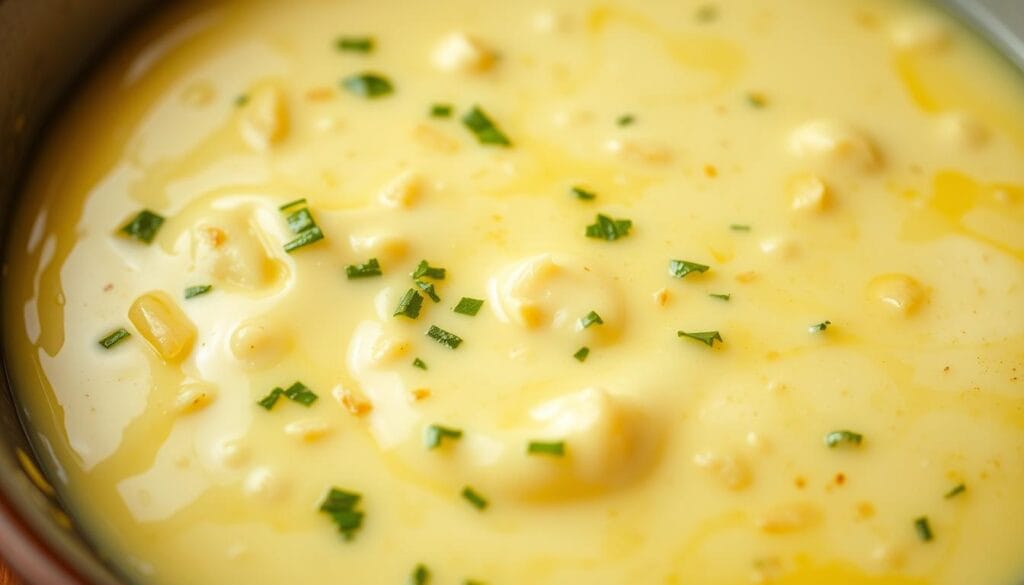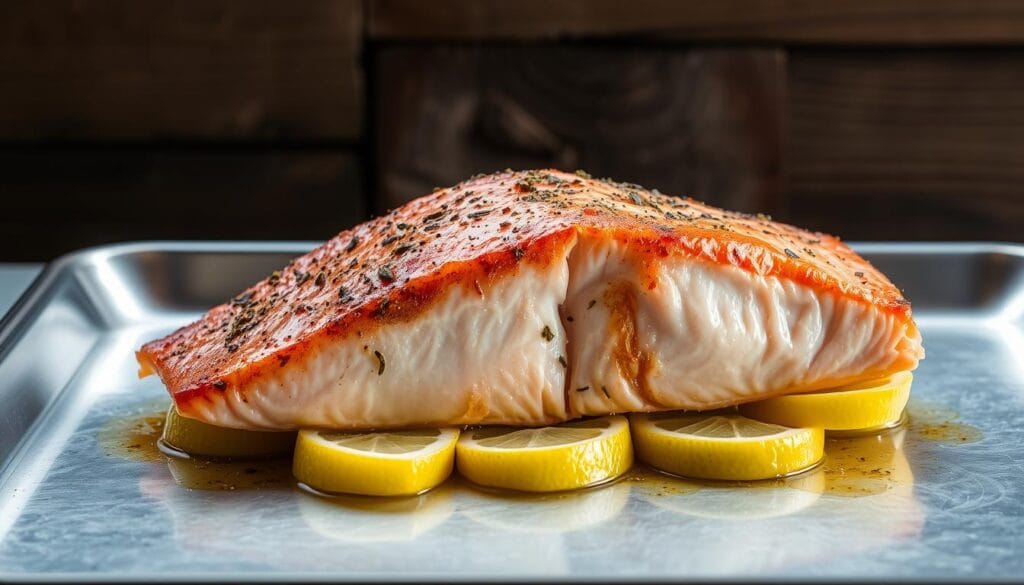Ever come home craving something rich and comforting, but racing against the clock? Enter Butter Salmon—the kind of dish that feels like a luxurious escape but comes together faster than your favorite takeout.
Imagine this: salmon fillets with a golden, crisped edge, bathed in a glossy, garlic-infused butter sauce. As it sizzles, the aroma fills your kitchen like a cozy embrace. It’s not a dream—it’s your dinner, ready in just 20 minutes.
So what makes Butter Salmon unforgettable? It’s that restaurant-level flavor built with simple techniques. The magic lies in a bubbling butter bath, spooned lovingly over the fish as it cooks. This continuous basting locks in juiciness, deepens flavor, and leaves you with a tender, melt-in-your-mouth finish.
You’ll learn the chef’s secret of timing and high heat—just enough to give a crisp sear without overcooking. We’ll guide you through picking the freshest salmon, balancing your seasoning, and nailing that silky texture every time.
By the time you plate it, you’ll feel like a culinary pro—turning any ordinary night into a gourmet experience. No stress, no reservations—just you, your skillet, and one stunning Butter Salmon dinner.
Table of Contents
Key Takeaways
- Whip up gourmet-quality fish in under 20 minutes.
- Master the basting technique for maximum flavor infusion.
- Achieve crispy edges and tender flesh with controlled heat.
- Select fresh, thick-cut fillets for optimal results.
- Learn pan-handling tricks for restaurant-worthy searing.
- Balance simplicity and elegance in one pan.
- Follow step-by-step guidance to impress at any meal.
Ingredients and Essential Prep Steps
Great meals start with smart shopping. Quality components transform simple recipes into memorable dishes—your choices here set the stage for success.
Gathering Your Ingredients
For this recipe, you’ll need:
- Fresh skin-on fillets (6-8 oz each)
- 4 garlic cloves
- 1 lemon
- Unsalted butter
- Olive oil
- Sea salt & black pepper
- Chopped fresh parsley
Skinless options work better for absorbing flavors, but skin-on cuts offer crisp texture. Bring fillets to room temperature 15 minutes before cooking—this prevents uneven cooking. Pat them dry thoroughly; moisture is the enemy of golden crusts.
Prepping the Salmon Fillets and Seasoning
Rub both sides with olive oil, then sprinkle generously with salt and pepper. For garlic, use a sharp knife—never a crusher—to create fine mince that won’t burn. Zest the lemon first, then juice it. Measure butter in tablespoons for precise control during cooking.
Pro tip: Arrange everything within arm’s reach. Timing matters once your pan heats up. Fresh parsley adds brightness, so chop it last to preserve color.
Step-by-Step Cooking Process
Transform your kitchen into a culinary studio with precise timing and technique. This method turns simple ingredients into a glossy masterpiece through controlled fire and motion.
Searing the Salmon to a Golden Perfection
Heat a stainless steel or cast-iron skillet over medium-high. Add 1 tbsp olive oil—it should shimmer but not smoke. Place fillets skin-side down (if using skin-on) and press gently for full contact. Wait 3 minutes without moving them—this builds the crust that locks in moisture.
Basting with the Foaming Garlic Butter
Flip fillets carefully using a fish spatula. Reduce heat to medium and add 3 tbsp butter. As it melts, tilt the pan to pool the liquid. Toss in minced garlic—it should sizzle softly, not brown. Immediately start spooning the foaming mixture over the fish every 15 seconds for 4-5 minutes.
Watch the edges: when they turn opaque but the center remains slightly translucent, remove from heat. Let rest 2 minutes—the residual warmth finishes cooking without drying. Pro tip: Use a timer to nail the 8-10 minute total cook window for medium doneness.
Butter Salmon Techniques for Maximum Flavor
Unlock the secret to restaurant-quality salmon with a simple yet transformative technique. While ingredients matter, execution determines whether your dish tastes homemade or haute cuisine. The magic happens when heat, fat, and motion work in harmony.
Continuous Basting for an Even Butter Coating
Basting isn’t just about adding flavor—it’s a temperature control system. As you spoon garlic-infused butter over the fillet, the fat gently cooks the top while the pan crisps the bottom. This dual-action method prevents dry spots and ensures every bite glistens.
Tilt your skillet slightly to pool the melted butter. Use a large spoon to repeatedly drizzle it over the fish, focusing on thicker areas first. “The constant liquid flow regulates heat better than any oven,” says a Michelin-trained chef. This creates a self-basting effect that keeps the protein tender.
Time this step carefully: 4-5 minutes of active basting gives the butter enough contact time without overcooking. The result? A glossy sauce clings to the fish, while minced garlic caramelizes into sweet, nutty notes. Serve immediately, letting excess butter pool beneath the fillet like a golden moat.
Master this rhythm, and you’ll turn weeknight dinners into culinary triumphs. Confidence grows with each perfectly cooked piece—silky inside, crisp outside, and utterly unforgettable.
Understanding the Role of Butter, Garlic, and Lemon
Three humble ingredients transform ordinary fish into a symphony of flavors. Each component plays a distinct role, creating layers that dance across your palate.

How Each Ingredient Enhances the Dish
Butter brings velvety richness, coating every fiber with luxurious texture. As it melts, it mingles with minced garlic, forming a golden garlic butter sauce that clings to the fish. This duo creates a savory base—garlic’s pungent edge softens into nutty sweetness under heat.
Lemon juice cuts through the richness like a bright spotlight. Added late in cooking, its acidity lifts heavy notes without overpowering. The citrus also jumpstarts caramelization, helping develop that coveted golden crust.
Pre-made sauces lack this dynamic interplay. Fresh garlic releases aromatic oils that pre-minced versions can’t match. Real lemon juice (not bottled) offers brighter acidity and subtle floral notes. “The difference between fresh and preserved ingredients is like night and day,” notes chef Elena Martinez.
Want more tang? Squeeze extra lemon juice after plating. Crave deeper savoriness? Add a pinch of smoked paprika to the butter sauce. This trio’s flexibility lets you tweak flavors while maintaining balance—a skill that turns cooks into artists.
Tips for Achieving the Perfect Salmon Texture
Texture separates good fish from unforgettable meals. Precision with heat and timing ensures that delicate flesh stays moist while developing a crave-worthy crust. Let’s break down the science of doneness.
Internal Temperature and Cooking Time Guidelines
Target 122°F (50°C) for medium-rare—the sweet spot where proteins relax without tightening. Use a digital thermometer inserted into the thickest part. Cook skin-side down for 3 minutes, then flip and baste for 4-5 minutes. Total cook time? Under 10 minutes.
Why does resting matter? Heat continues spreading inward for 2 minutes off the stove. Juices redistribute, preventing dry edges. Watch for visual cues: flesh turns opaque pink, and flakes separate gently when nudged.
Leftovers? Cool completely before refrigerating in an airtight container. Reheat gently in a covered pan with a splash of water. Never microwave—it turns tender bites rubbery.
Do:
– Check temp early to avoid overshooting
– Let fillets rest at room temperature pre-cook
– Use fresh, thick cuts for even cooking
Don’t:
– Overcrowd the pan (steam softens crusts)
– Skip the thermometer (guessing leads to dryness)
– Cook straight from the fridge (uneven results)
Alternative Methods: Pan-Searing and Oven-Baking
Your skillet isn’t the only path to perfection. While stovetop cooking delivers speed, combining techniques unlocks new textures and flavors. Let’s explore oven-friendly approaches that adapt to your kitchen setup.

The Benefits of the Sear-Then-Baste Technique
Start with a hot pan to create a golden crust, then transfer fillets to a 400°F oven. This hybrid method ensures even cooking for thicker cuts. Line a baking tray with foil and nest lemon slices beneath the fish—their citrus steam keeps flesh moist while adding subtle tang.
Why choose this route? Oven heat surrounds the protein gently, reducing the risk of overcooking. You’ll gain 2-3 extra minutes to prep sides or adjust seasoning. “The pan-to-oven shift mimics professional kitchen workflows,” explains chef Marco Visconti.
Exploring Sheet Pan and Broiler Variations
For hands-off ease, arrange seasoned fillets on a sheet pan brushed with olive oil. Bake at 425°F for 12 minutes, then switch to broil. Two minutes under high heat crisps the surface without drying the center—ideal for meal prepping multiple servings.
Key differences:
- Pan methods: Faster (8-10 minutes), intense butter infusion
- Oven methods: Hands-free, better for thicker cuts
Both approaches work with skin-on or skinless options. Use a thermometer to check for 120-125°F before resting. Want caramelized edges? Sprinkle a pinch of sugar over fillets before broiling.
Side Pairing Ideas to Complement Your Butter Salmon
Your golden-crusted masterpiece deserves equally stunning companions. The right sides transform a single dish into a symphony of textures and flavors, balancing richness with brightness. Let’s explore combinations that enhance without competing.
Classic Sides: Mashed Potatoes and Steamed Greens
Velvety mashed potatoes act like edible sponges, soaking up every drop of garlic butter sauce. For extra flair, fold roasted garlic or chives into your spuds. Pair with quick-steamed broccoli or asparagus—their earthy notes cut through the dish’s richness.
Need crunch? Toss greens with toasted almonds. A squeeze of lemon over both components ties the plate together. “Starchy sides anchor rich proteins, creating meal balance,” notes culinary instructor Rachel Park.
Refreshing Salads and Roasted Vegetables
Crisp salads bring lively contrast. Try arugula with shaved fennel and orange segments—citrus mirrors the sauce’s brightness. Roasted carrots or Brussels sprouts caramelize beautifully, adding sweet depth.
| Side Type | Best For | Prep Time | Flavor Profile |
|---|---|---|---|
| Garlic mashed potatoes | Comfort dinners | 25 mins | Creamy, savory |
| Lemon-parsley salad | Summer meals | 10 mins | Zesty, fresh |
| Honey-glazed carrots | Holiday spreads | 30 mins | Sweet, earthy |
| Sautéed spinach | Quick weeknights | 7 mins | Nutty, mild |
Seasonal produce keeps meals exciting. Spring peas? Toss with mint. Fall squash? Roast with sage. Drizzle sides with olive oil for cohesion. Whether hosting or feeding family, these pairings turn plates into curated experiences.
Meal Prep, Storage, and Reheating Guidelines
Keep your culinary wins tasting fresh days later with smart storage strategies. Proper handling preserves texture and flavor, letting you enjoy restaurant-quality meals even on hectic weeknights.
Tips for Safely Storing Leftover Salmon
Transfer cooled fillets to an airtight container within 2 hours of cooking. Layer parchment paper between pieces to prevent sticking. Store in the fridge for up to 3-4 days—any longer risks flavor loss.
Reheat gently: place fillets in a skillet with 1 tbsp water over low heat. Cover and warm for 4-5 minutes. For oven use, set to 275°F and bake foil-wrapped portions for 10 minutes. Avoid high heat—it dries delicate flesh.
Leftovers shine in new recipes. Flake chilled pieces into salads or grain bowls. Top pizzas for a protein boost. The garlic butter sauce retains its silky texture when stored properly—just stir before reheating.
Label containers with dates to track freshness. Organized meal prep turns leftovers into planned-ahead delights. “Treat stored fish like precious cargo,” advises food safety expert Dr. Lena Torres. Your future self will thank you when dinner comes together in minutes.
Common Mistakes and How to Avoid Them
Even skilled cooks can stumble when balancing speed and precision. Recognizing these pitfalls early helps preserve your dish’s silky texture and delicate flavors.
Heat Management Is Everything
High flames turn garlic bitter within seconds. Keep your burner at medium after the initial sear—this lets butter foam without smoking. Chef Ana Ramirez warns: “Burnt garlic ruins sauces faster than overcooked fish.”
Seasoning and Tool Traps
Avoid garlic presses—they create uneven pieces that burn instantly. Instead, use a sharp knife for uniform mincing. Too much salt pepper upfront? Taste as you go, adding small pinches after basting.
Over-basting drowns fillets in grease. Spoon butter just enough to coat—not submerge—the surface. If your pan looks crowded, cook in batches. Crowding lowers temperature, leading to steamed rather than seared results.
Watch for visual cues: golden edges signal perfect doneness. Let rest 2 minutes off heat—the fish continues cooking internally. “Patience prevents rubbery textures,” says seafood specialist Mark Liang.
With these fixes, you’ll master temperature control and seasoning balance. Your garlic butter sauce will cling like liquid gold, never overwhelming the star ingredient.
Conclusion
Imagine plating a dish that dazzles guests yet fits seamlessly into your evening routine. This butter salmon recipe delivers precisely that—luxurious texture meets weeknight practicality. From prepping room-temperature fillets to mastering the garlic-infused baste, each step builds toward silky perfection.
Follow the 20-minute timeline, and you’ll unlock a restaurant-worthy dinner every time. The golden sear locks in moisture, while continuous basting wraps each bite in velvety richness. Pair it with mashed potatoes or roasted veggies for a complete meal that feels special without stress.
Leftovers? Store them properly, and you’ve got tomorrow’s lunch ready. Toss flakes into salads or grain bowls for instant upgrades. Don’t forget that final sprinkle of fresh parsley—its bright pop elevates presentation and flavor.
Ready to impress? Grab your skillet and let the sizzle begin. Share your creations online, then revisit this guide whenever cravings strike. With attention to detail and quality ingredients, you’re three steps from unforgettable dining—no chef’s coat required.
FAQ
Can I use frozen fillets for this recipe?
What’s the best way to prevent garlic from burning?
How do I know when it’s cooked through?
Can I substitute olive oil for butter?
How long do leftovers stay fresh?
What sides pair well with this dish?
Can I bake it instead of pan-searing?
Why does my sauce sometimes split?
Try These Next:
- Gluten-Free Desserts for Busy Professionals
- Dairy-Free & Gluten-Free Soup Ideas
- Healthy Weeknight Meals

I truly appreciate this post. I have been looking everywhere for this! Thank goodness I found it on Bing. You have made my day! Thank you again
I like this blog very much, Its a real nice office to read and obtain information. “I’d better get off the phone now, I’ve already told you more than I heard myself.” by Loretta Lockhorn.